Evolution of Management Theory and Practice: A Detailed Analysis
VerifiedAdded on 2023/01/12
|10
|1124
|76
Report
AI Summary
This report provides an overview of the evolution of management theory and practice. It begins by discussing Total Quality Management (TQM) and its benefits, such as cost reduction and customer satisfaction, while also addressing its challenges. The report then explores Lean Production and Just-in-Time (JIT) manufacturing, highlighting their importance in reducing costs and improving efficiency by eliminating waste. The role of technological innovation as a driver of change is examined, emphasizing its impact on reducing bureaucracy and fostering transparency. The report also addresses environmental sustainability issues and the evolving landscape of capitalism, concluding with a summary of the key takeaways. This report is a valuable resource for students seeking to understand the key concepts and trends in modern management.
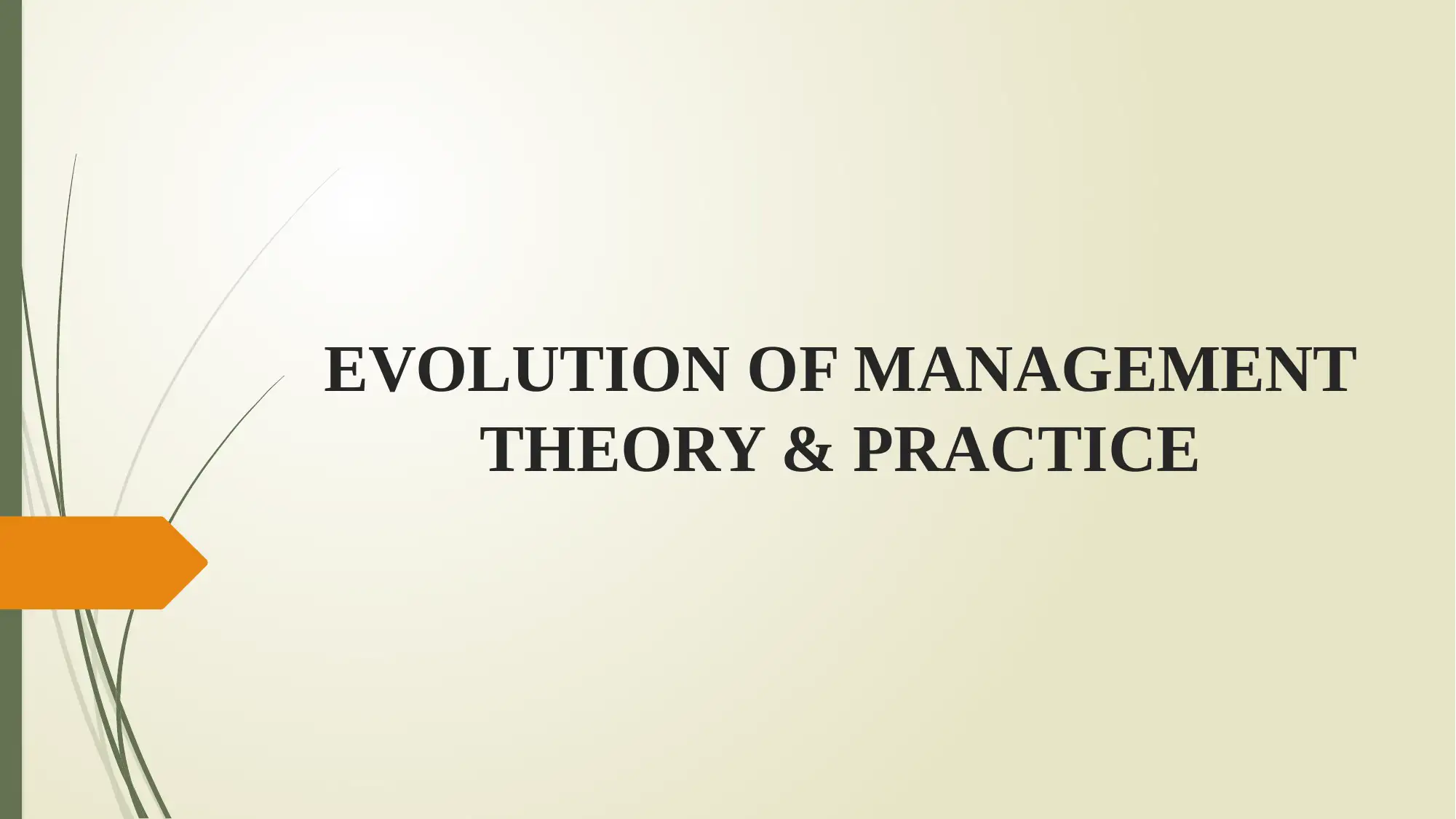
EVOLUTION OF MANAGEMENT
THEORY & PRACTICE
THEORY & PRACTICE
Paraphrase This Document
Need a fresh take? Get an instant paraphrase of this document with our AI Paraphraser
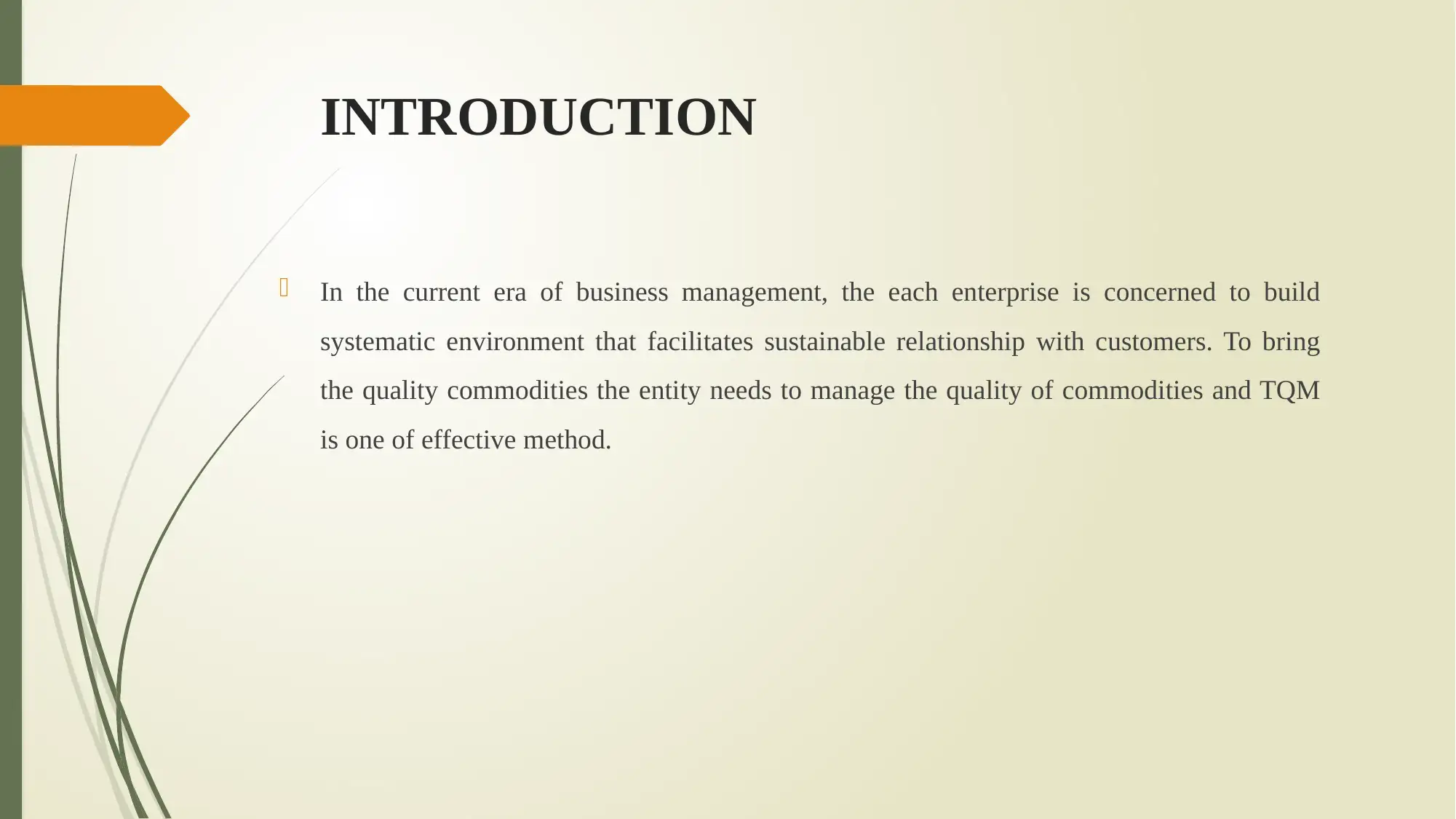
INTRODUCTION
In the current era of business management, the each enterprise is concerned to build
systematic environment that facilitates sustainable relationship with customers. To bring
the quality commodities the entity needs to manage the quality of commodities and TQM
is one of effective method.
In the current era of business management, the each enterprise is concerned to build
systematic environment that facilitates sustainable relationship with customers. To bring
the quality commodities the entity needs to manage the quality of commodities and TQM
is one of effective method.
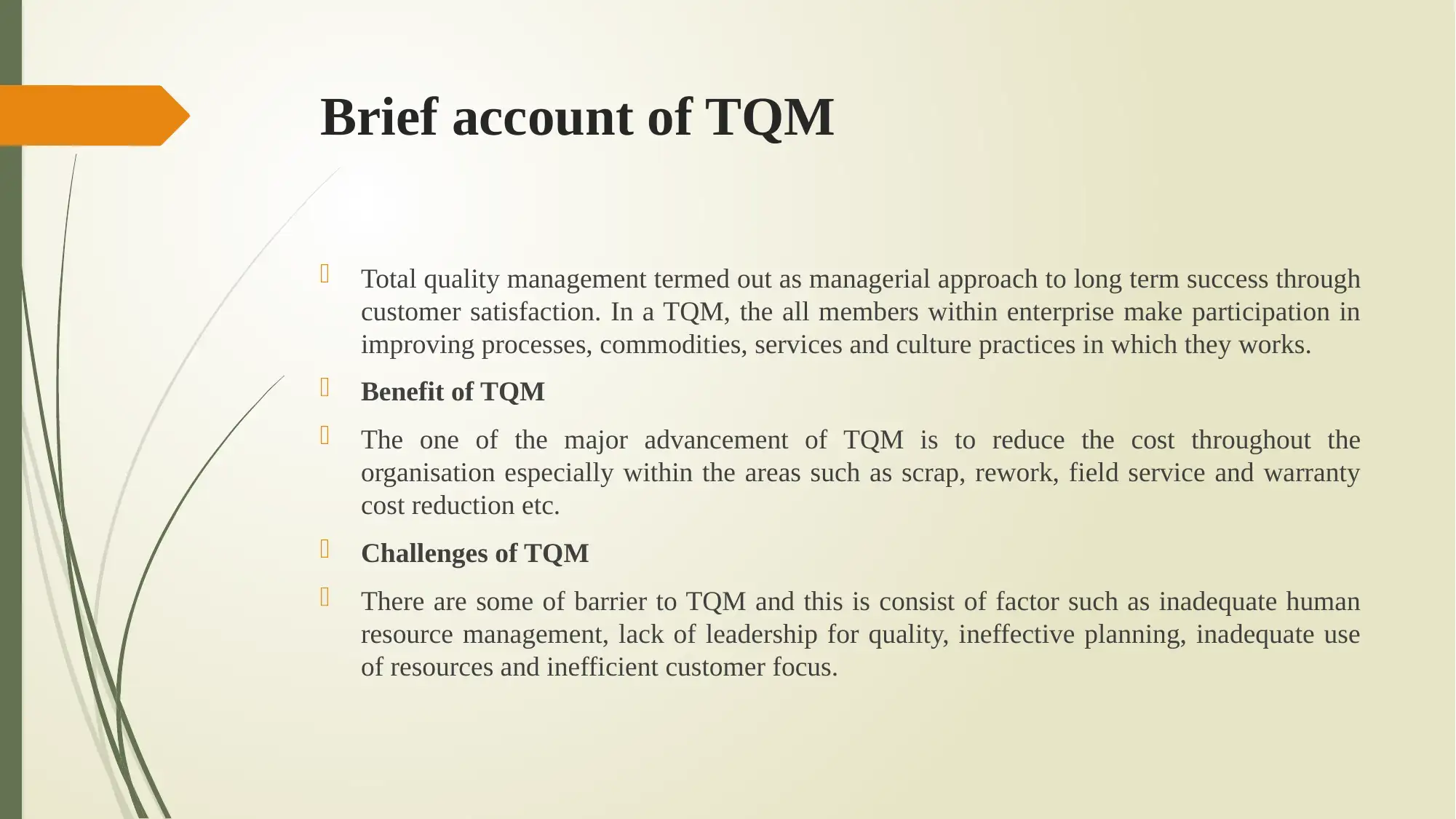
Brief account of TQM
Total quality management termed out as managerial approach to long term success through
customer satisfaction. In a TQM, the all members within enterprise make participation in
improving processes, commodities, services and culture practices in which they works.
Benefit of TQM
The one of the major advancement of TQM is to reduce the cost throughout the
organisation especially within the areas such as scrap, rework, field service and warranty
cost reduction etc.
Challenges of TQM
There are some of barrier to TQM and this is consist of factor such as inadequate human
resource management, lack of leadership for quality, ineffective planning, inadequate use
of resources and inefficient customer focus.
Total quality management termed out as managerial approach to long term success through
customer satisfaction. In a TQM, the all members within enterprise make participation in
improving processes, commodities, services and culture practices in which they works.
Benefit of TQM
The one of the major advancement of TQM is to reduce the cost throughout the
organisation especially within the areas such as scrap, rework, field service and warranty
cost reduction etc.
Challenges of TQM
There are some of barrier to TQM and this is consist of factor such as inadequate human
resource management, lack of leadership for quality, ineffective planning, inadequate use
of resources and inefficient customer focus.
⊘ This is a preview!⊘
Do you want full access?
Subscribe today to unlock all pages.

Trusted by 1+ million students worldwide
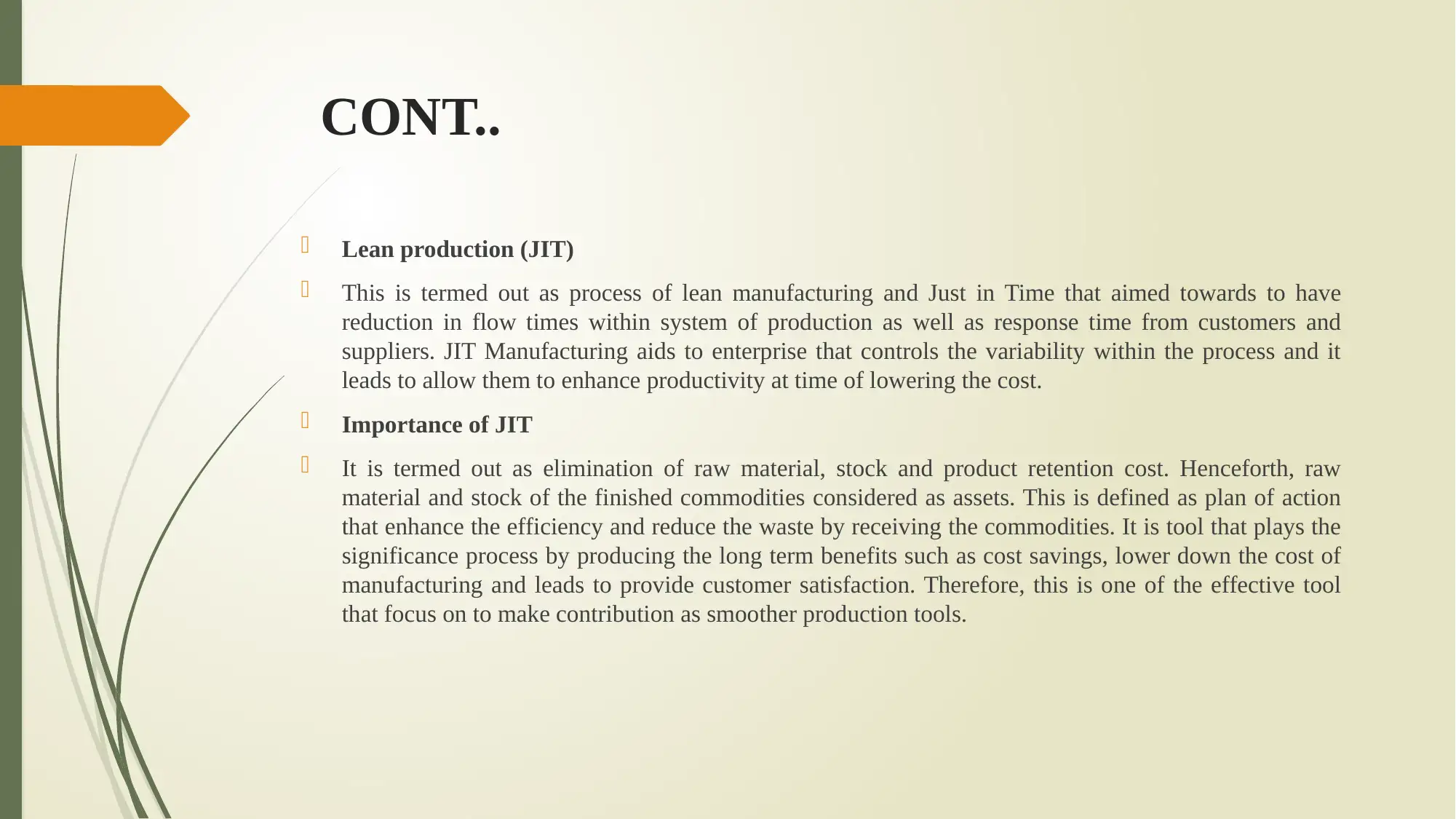
CONT..
Lean production (JIT)
This is termed out as process of lean manufacturing and Just in Time that aimed towards to have
reduction in flow times within system of production as well as response time from customers and
suppliers. JIT Manufacturing aids to enterprise that controls the variability within the process and it
leads to allow them to enhance productivity at time of lowering the cost.
Importance of JIT
It is termed out as elimination of raw material, stock and product retention cost. Henceforth, raw
material and stock of the finished commodities considered as assets. This is defined as plan of action
that enhance the efficiency and reduce the waste by receiving the commodities. It is tool that plays the
significance process by producing the long term benefits such as cost savings, lower down the cost of
manufacturing and leads to provide customer satisfaction. Therefore, this is one of the effective tool
that focus on to make contribution as smoother production tools.
Lean production (JIT)
This is termed out as process of lean manufacturing and Just in Time that aimed towards to have
reduction in flow times within system of production as well as response time from customers and
suppliers. JIT Manufacturing aids to enterprise that controls the variability within the process and it
leads to allow them to enhance productivity at time of lowering the cost.
Importance of JIT
It is termed out as elimination of raw material, stock and product retention cost. Henceforth, raw
material and stock of the finished commodities considered as assets. This is defined as plan of action
that enhance the efficiency and reduce the waste by receiving the commodities. It is tool that plays the
significance process by producing the long term benefits such as cost savings, lower down the cost of
manufacturing and leads to provide customer satisfaction. Therefore, this is one of the effective tool
that focus on to make contribution as smoother production tools.
Paraphrase This Document
Need a fresh take? Get an instant paraphrase of this document with our AI Paraphraser
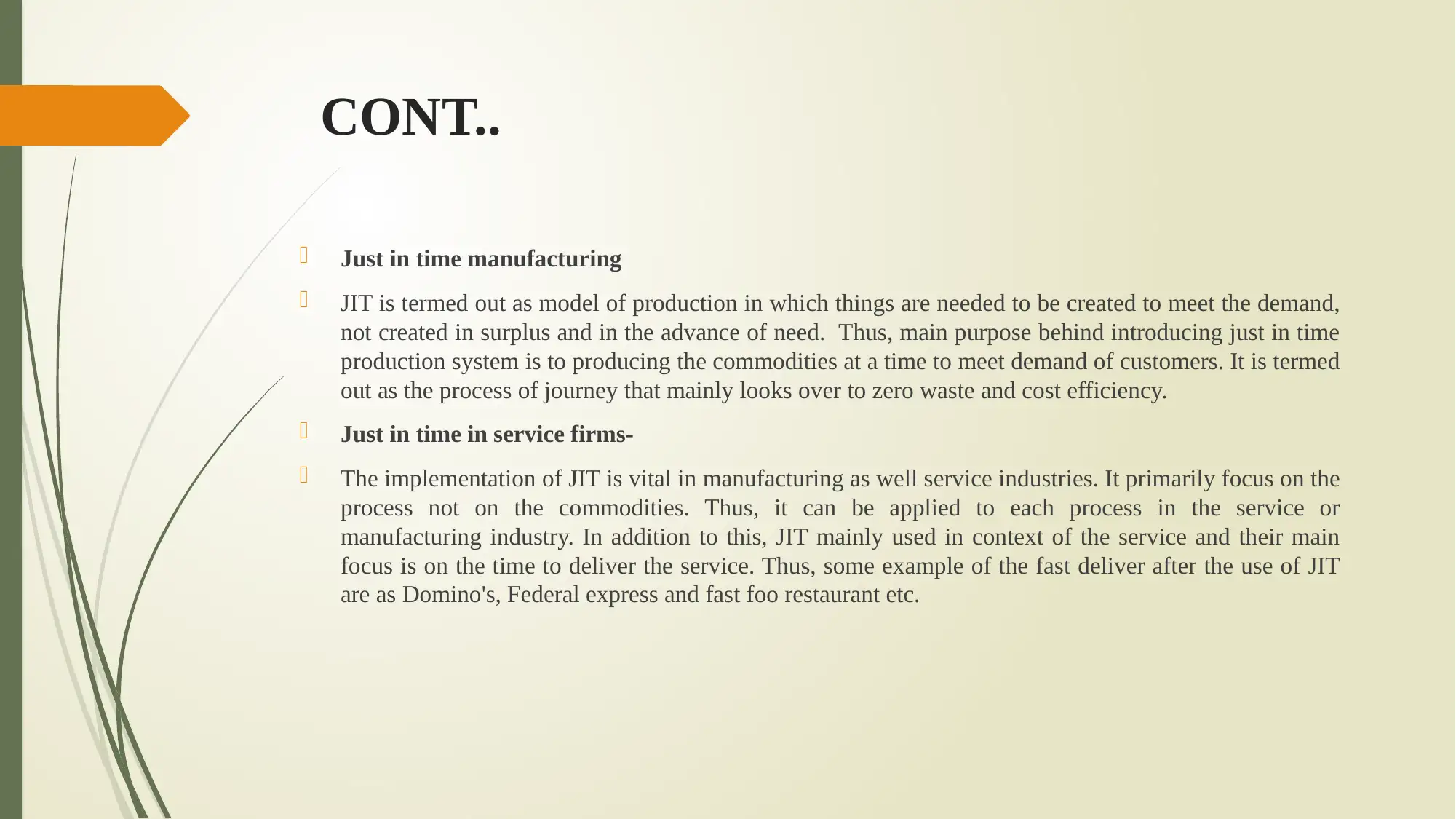
CONT..
Just in time manufacturing
JIT is termed out as model of production in which things are needed to be created to meet the demand,
not created in surplus and in the advance of need. Thus, main purpose behind introducing just in time
production system is to producing the commodities at a time to meet demand of customers. It is termed
out as the process of journey that mainly looks over to zero waste and cost efficiency.
Just in time in service firms-
The implementation of JIT is vital in manufacturing as well service industries. It primarily focus on the
process not on the commodities. Thus, it can be applied to each process in the service or
manufacturing industry. In addition to this, JIT mainly used in context of the service and their main
focus is on the time to deliver the service. Thus, some example of the fast deliver after the use of JIT
are as Domino's, Federal express and fast foo restaurant etc.
Just in time manufacturing
JIT is termed out as model of production in which things are needed to be created to meet the demand,
not created in surplus and in the advance of need. Thus, main purpose behind introducing just in time
production system is to producing the commodities at a time to meet demand of customers. It is termed
out as the process of journey that mainly looks over to zero waste and cost efficiency.
Just in time in service firms-
The implementation of JIT is vital in manufacturing as well service industries. It primarily focus on the
process not on the commodities. Thus, it can be applied to each process in the service or
manufacturing industry. In addition to this, JIT mainly used in context of the service and their main
focus is on the time to deliver the service. Thus, some example of the fast deliver after the use of JIT
are as Domino's, Federal express and fast foo restaurant etc.
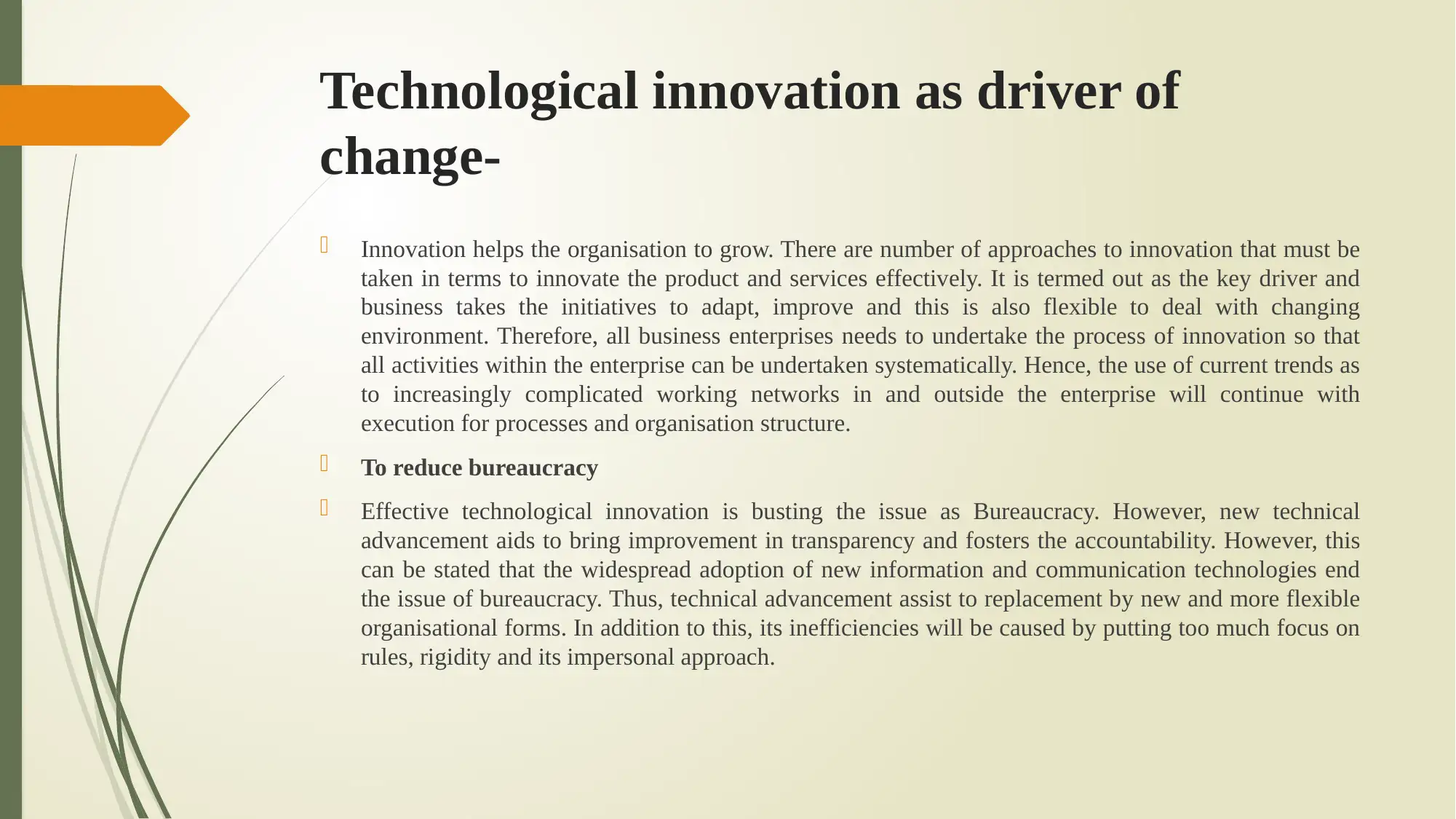
Technological innovation as driver of
change-
Innovation helps the organisation to grow. There are number of approaches to innovation that must be
taken in terms to innovate the product and services effectively. It is termed out as the key driver and
business takes the initiatives to adapt, improve and this is also flexible to deal with changing
environment. Therefore, all business enterprises needs to undertake the process of innovation so that
all activities within the enterprise can be undertaken systematically. Hence, the use of current trends as
to increasingly complicated working networks in and outside the enterprise will continue with
execution for processes and organisation structure.
To reduce bureaucracy
Effective technological innovation is busting the issue as Bureaucracy. However, new technical
advancement aids to bring improvement in transparency and fosters the accountability. However, this
can be stated that the widespread adoption of new information and communication technologies end
the issue of bureaucracy. Thus, technical advancement assist to replacement by new and more flexible
organisational forms. In addition to this, its inefficiencies will be caused by putting too much focus on
rules, rigidity and its impersonal approach.
change-
Innovation helps the organisation to grow. There are number of approaches to innovation that must be
taken in terms to innovate the product and services effectively. It is termed out as the key driver and
business takes the initiatives to adapt, improve and this is also flexible to deal with changing
environment. Therefore, all business enterprises needs to undertake the process of innovation so that
all activities within the enterprise can be undertaken systematically. Hence, the use of current trends as
to increasingly complicated working networks in and outside the enterprise will continue with
execution for processes and organisation structure.
To reduce bureaucracy
Effective technological innovation is busting the issue as Bureaucracy. However, new technical
advancement aids to bring improvement in transparency and fosters the accountability. However, this
can be stated that the widespread adoption of new information and communication technologies end
the issue of bureaucracy. Thus, technical advancement assist to replacement by new and more flexible
organisational forms. In addition to this, its inefficiencies will be caused by putting too much focus on
rules, rigidity and its impersonal approach.
⊘ This is a preview!⊘
Do you want full access?
Subscribe today to unlock all pages.

Trusted by 1+ million students worldwide
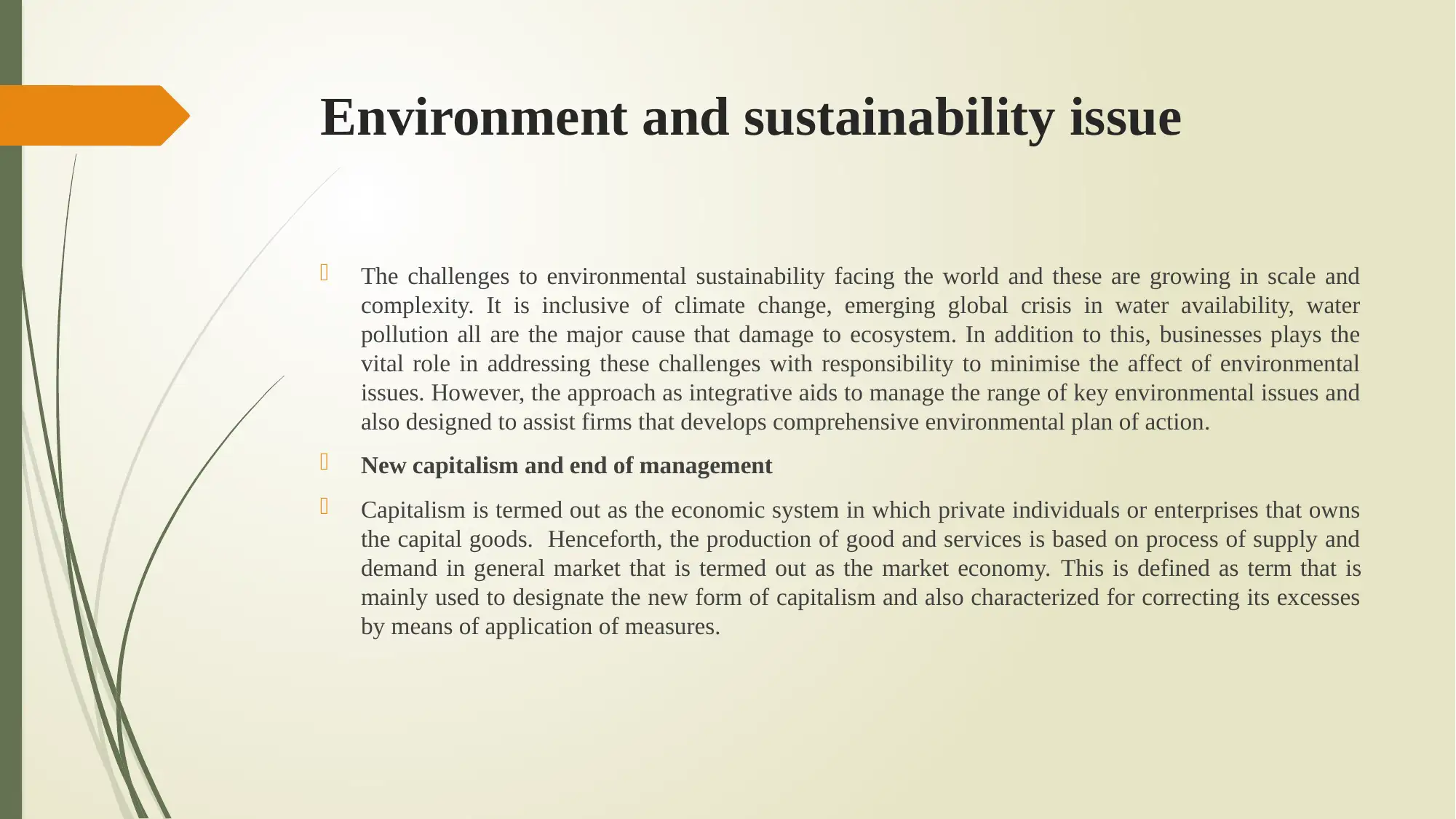
Environment and sustainability issue
The challenges to environmental sustainability facing the world and these are growing in scale and
complexity. It is inclusive of climate change, emerging global crisis in water availability, water
pollution all are the major cause that damage to ecosystem. In addition to this, businesses plays the
vital role in addressing these challenges with responsibility to minimise the affect of environmental
issues. However, the approach as integrative aids to manage the range of key environmental issues and
also designed to assist firms that develops comprehensive environmental plan of action.
New capitalism and end of management
Capitalism is termed out as the economic system in which private individuals or enterprises that owns
the capital goods. Henceforth, the production of good and services is based on process of supply and
demand in general market that is termed out as the market economy. This is defined as term that is
mainly used to designate the new form of capitalism and also characterized for correcting its excesses
by means of application of measures.
The challenges to environmental sustainability facing the world and these are growing in scale and
complexity. It is inclusive of climate change, emerging global crisis in water availability, water
pollution all are the major cause that damage to ecosystem. In addition to this, businesses plays the
vital role in addressing these challenges with responsibility to minimise the affect of environmental
issues. However, the approach as integrative aids to manage the range of key environmental issues and
also designed to assist firms that develops comprehensive environmental plan of action.
New capitalism and end of management
Capitalism is termed out as the economic system in which private individuals or enterprises that owns
the capital goods. Henceforth, the production of good and services is based on process of supply and
demand in general market that is termed out as the market economy. This is defined as term that is
mainly used to designate the new form of capitalism and also characterized for correcting its excesses
by means of application of measures.
Paraphrase This Document
Need a fresh take? Get an instant paraphrase of this document with our AI Paraphraser
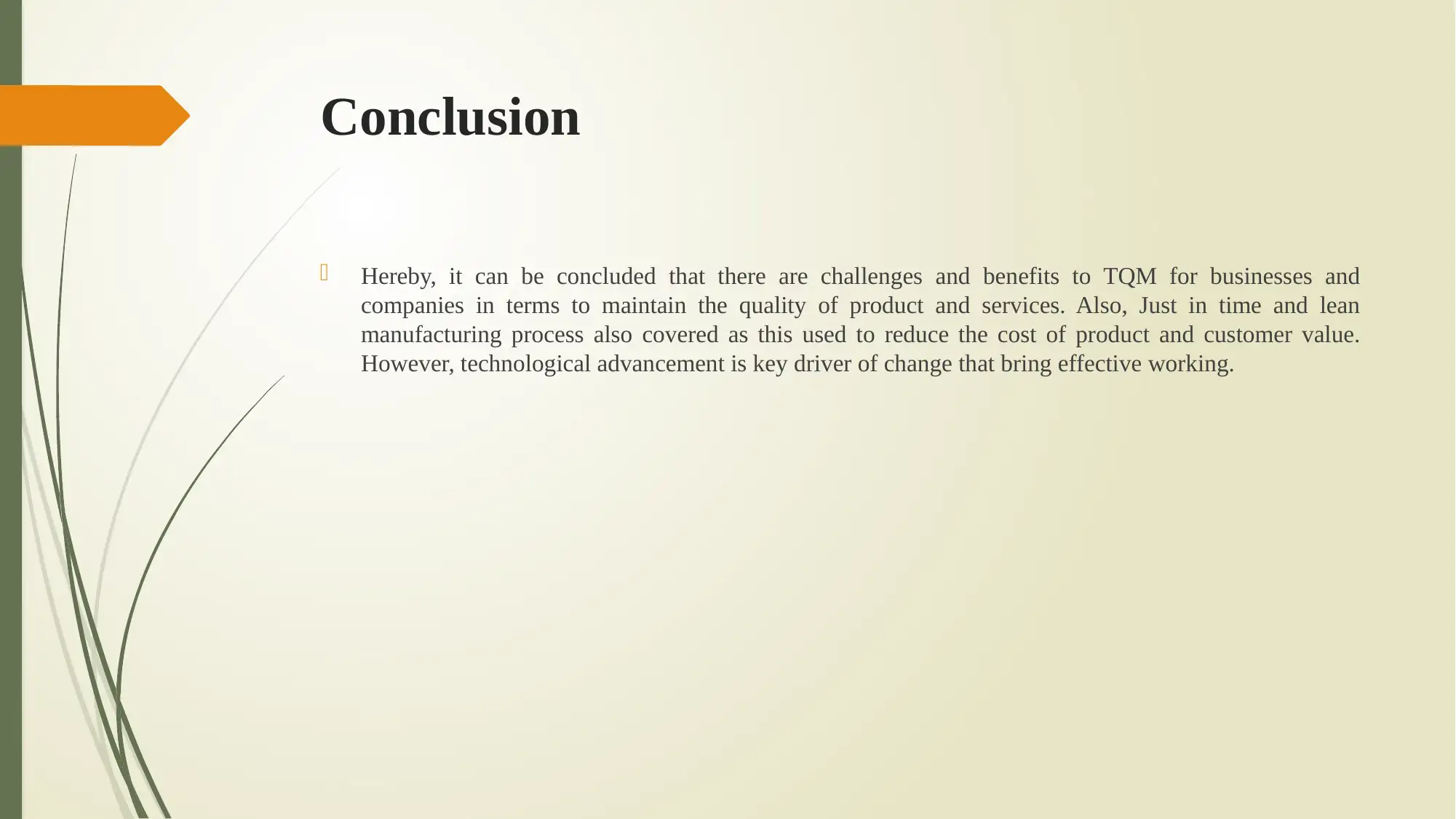
Conclusion
Hereby, it can be concluded that there are challenges and benefits to TQM for businesses and
companies in terms to maintain the quality of product and services. Also, Just in time and lean
manufacturing process also covered as this used to reduce the cost of product and customer value.
However, technological advancement is key driver of change that bring effective working.
Hereby, it can be concluded that there are challenges and benefits to TQM for businesses and
companies in terms to maintain the quality of product and services. Also, Just in time and lean
manufacturing process also covered as this used to reduce the cost of product and customer value.
However, technological advancement is key driver of change that bring effective working.
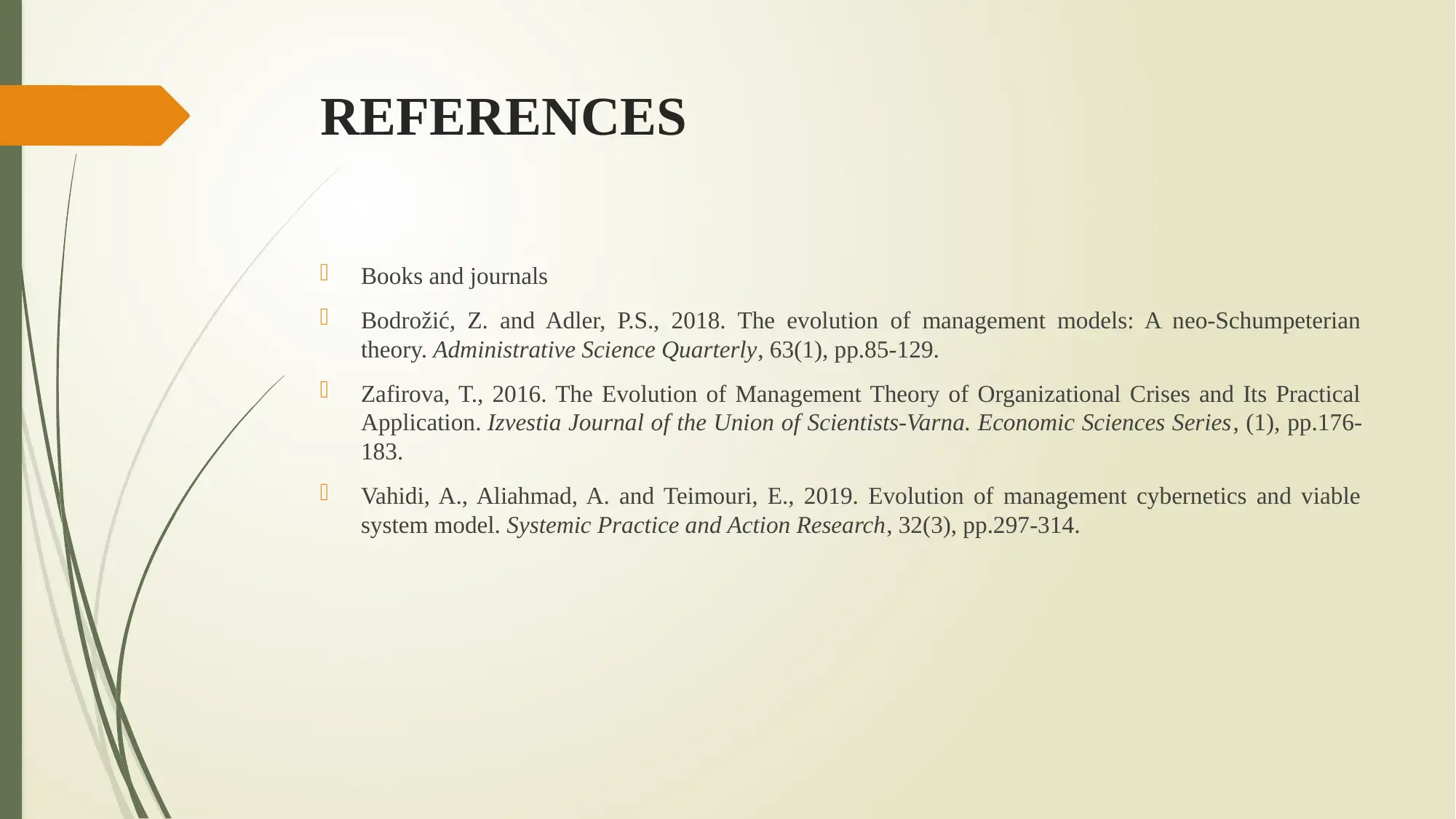
REFERENCES
Books and journals
Bodrožić, Z. and Adler, P.S., 2018. The evolution of management models: A neo-Schumpeterian
theory. Administrative Science Quarterly, 63(1), pp.85-129.
Zafirova, T., 2016. The Evolution of Management Theory of Organizational Crises and Its Practical
Application. Izvestia Journal of the Union of Scientists-Varna. Economic Sciences Series, (1), pp.176-
183.
Vahidi, A., Aliahmad, A. and Teimouri, E., 2019. Evolution of management cybernetics and viable
system model. Systemic Practice and Action Research, 32(3), pp.297-314.
Books and journals
Bodrožić, Z. and Adler, P.S., 2018. The evolution of management models: A neo-Schumpeterian
theory. Administrative Science Quarterly, 63(1), pp.85-129.
Zafirova, T., 2016. The Evolution of Management Theory of Organizational Crises and Its Practical
Application. Izvestia Journal of the Union of Scientists-Varna. Economic Sciences Series, (1), pp.176-
183.
Vahidi, A., Aliahmad, A. and Teimouri, E., 2019. Evolution of management cybernetics and viable
system model. Systemic Practice and Action Research, 32(3), pp.297-314.
⊘ This is a preview!⊘
Do you want full access?
Subscribe today to unlock all pages.

Trusted by 1+ million students worldwide

THANK YOU
1 out of 10
Related Documents
Your All-in-One AI-Powered Toolkit for Academic Success.
+13062052269
info@desklib.com
Available 24*7 on WhatsApp / Email
![[object Object]](/_next/static/media/star-bottom.7253800d.svg)
Unlock your academic potential
Copyright © 2020–2025 A2Z Services. All Rights Reserved. Developed and managed by ZUCOL.





